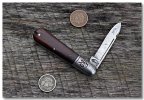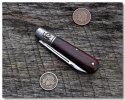Primble
Gold Member
- Joined
- Mar 31, 2014
- Messages
- 8,640
Fayetteville Knife Company Small Barlow (2 & 15/16" closed length), Fayetteville, N.Y., U.S.A., circa 1880-1911
This particular knife arrived and the wood handles had raised grain and some ugly marks near the butt of the knife. The bolster and blade patina were nice and I wanted to leave the knife as original as possible, so little time spent on cleaning this one. I did lightly sand out the rough spots near the butt and used a mixture of solvents and fine steel wool to dissolve the old grime off the handles. What appeared at first to be black ebony turned out to be a very pretty color of dark reddish brown, probably Rosewood, but, possibly it is Cocobolo. I rubbed the wood a little more with dry steel wool and added some Briwax, oiled the joints, and called it a day. It is a beautiful little antique Barlow to my eye now. It still has some nice snap to it and half stops. The wood is tight and even to the bolsters and liners. The bolsters, liners, and pins are steel construction.
According to Goins, Fayetteville Knife Company c. 1911 - FKCO is stamped on the bolster of small Barlows, Father of Barlows is stamped on the bolster of daddy barlows. No record of this firm is in the Fayetteville, New York directories.
However, Mr. Joseph Stanton (Stantons market) remembers this firm as being located in Fayetteville on Mill Street. He says it was on the plot of ground next to McIntire Paper Company. Mr. Stanton lived a few doors away, and as a child of about four years of age, he remembers standing in front of his home and watching the knife factory burn. This would have been about 1911. As far as it can be ascertained, it was never re-opened.
While researching a bit further, I happened to run across this tariff commission document showing the factory in existence in 1882. I believe it can be assumed that the company was established at least a few years prior to the hearings so as to be listed with other major manufacturers.
The tariff commission was being asked by the major manufacturers to increase the tariffs on German made knives that were being imported and sold as New England Knife Company knives.
Fayetteville today is a suburb of Syracuse, New York. The population of Fayetteville in the year 1910 was 1,481 persons.
I located a Newspaper archive from the Fayette Bulletin, located in the small settlement of Fayetteville, New York. I personally spent some time reading the front page of the weekly newpaper from the year 1911, (52 issues of it in fact) hoping to find more information about the fire and/or Fayetteville Knife Company mentions. I learned that a Mr. Stanton was a man of some stature in the community and mentioned in the news articles frequently. I learned of a fire on a windy night that consumed an old knife factory, but, no specifics.
I ran across a story that told of a house cat jumping on the kitchen table of a residence there and knocked a burning oil lamp on the floor. Although the family escaped, the home was in ashes minutes later, according to the article. I found it interesting that the insurance company paid for the loss of the house, at a grand total of eight hundred dollars. There were many other articles which proved to be of interest to me, including a couple murders in the small community.
There seemed to be a strong connection to Utica, New York, which was located 45 miles east of Fayetteville.


This particular knife arrived and the wood handles had raised grain and some ugly marks near the butt of the knife. The bolster and blade patina were nice and I wanted to leave the knife as original as possible, so little time spent on cleaning this one. I did lightly sand out the rough spots near the butt and used a mixture of solvents and fine steel wool to dissolve the old grime off the handles. What appeared at first to be black ebony turned out to be a very pretty color of dark reddish brown, probably Rosewood, but, possibly it is Cocobolo. I rubbed the wood a little more with dry steel wool and added some Briwax, oiled the joints, and called it a day. It is a beautiful little antique Barlow to my eye now. It still has some nice snap to it and half stops. The wood is tight and even to the bolsters and liners. The bolsters, liners, and pins are steel construction.
According to Goins, Fayetteville Knife Company c. 1911 - FKCO is stamped on the bolster of small Barlows, Father of Barlows is stamped on the bolster of daddy barlows. No record of this firm is in the Fayetteville, New York directories.
However, Mr. Joseph Stanton (Stantons market) remembers this firm as being located in Fayetteville on Mill Street. He says it was on the plot of ground next to McIntire Paper Company. Mr. Stanton lived a few doors away, and as a child of about four years of age, he remembers standing in front of his home and watching the knife factory burn. This would have been about 1911. As far as it can be ascertained, it was never re-opened.
While researching a bit further, I happened to run across this tariff commission document showing the factory in existence in 1882. I believe it can be assumed that the company was established at least a few years prior to the hearings so as to be listed with other major manufacturers.
The tariff commission was being asked by the major manufacturers to increase the tariffs on German made knives that were being imported and sold as New England Knife Company knives.
Fayetteville today is a suburb of Syracuse, New York. The population of Fayetteville in the year 1910 was 1,481 persons.
I located a Newspaper archive from the Fayette Bulletin, located in the small settlement of Fayetteville, New York. I personally spent some time reading the front page of the weekly newpaper from the year 1911, (52 issues of it in fact) hoping to find more information about the fire and/or Fayetteville Knife Company mentions. I learned that a Mr. Stanton was a man of some stature in the community and mentioned in the news articles frequently. I learned of a fire on a windy night that consumed an old knife factory, but, no specifics.
I ran across a story that told of a house cat jumping on the kitchen table of a residence there and knocked a burning oil lamp on the floor. Although the family escaped, the home was in ashes minutes later, according to the article. I found it interesting that the insurance company paid for the loss of the house, at a grand total of eight hundred dollars. There were many other articles which proved to be of interest to me, including a couple murders in the small community.
There seemed to be a strong connection to Utica, New York, which was located 45 miles east of Fayetteville.


Last edited:


